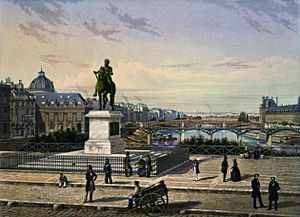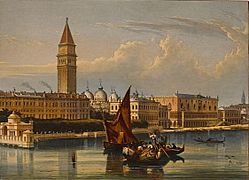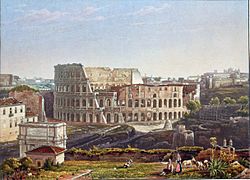Noël Paymal Lerebours facts for kids
Quick facts for kids
Noël Marie Paymal Lerebours
|
|
|---|---|

Lerebours in Paris, c. 1843 daguerreotype by Jean-Gabriel Eynard
|
|
| Born | February 16, 1807 Paris
|
| Died | July 23, 1873 (aged 66) Neuilly-sur-Seine
|
| Nationality | French |
| Occupation | optician |
| Known for | daguerreotypist |
|
Notable work
|
Excursions Daguerriennes |
Noël Marie Paymal Lerebours (born February 16, 1807 – died July 23, 1873) was a talented French optician and a pioneer in early photography. An optician is someone who makes or sells optical instruments like lenses and telescopes. He was also a daguerreotypist, which means he created a very early type of photograph called a daguerreotype.
Lerebours is most famous for his books, Excursions Daguerriennes. These books showed pictures of famous places around the world. The images were based on early photographs, but they were redrawn by hand as special prints called aquatint engravings.
Contents
Early Life and Work
Noël Lerebours was born in Paris. His mother, Marie Jeanne Françoise Paymal, was a seamstress. Later, his mother married Jean Lerebours, who was an optician. Jean Lerebours adopted Noël in 1836.
When his adoptive father passed away, Noël Lerebours took over the family's optician shop. It was located in a famous area of Paris called Place du Pont-Neuf. In 1845, he teamed up with Marc Secretan. Their company became known as Lerebours et Secretan.
Besides making excellent lenses for telescopes and observatories, Lerebours was very interested in photography. From 1840 to 1850, he worked hard to make daguerreotype photography even better.
Lerebours' Photography Career
In 1839, Lerebours used his skills in optics to create and sell his own camera. It was a sliding box camera, similar to the one described in the instructions for Daguerre's original invention.
Taking Royal Portraits
Lerebours became very busy with photography. In 1842, he noted that he had taken 1,500 portraits in just two months. Among these important pictures were daguerreotypes of the King of France, Louis-Philippe, and Queen Amélie.
He took these royal portraits in June or July 1842. Lerebours and another photographer, Antoine Claudet, used daylight from the large windows of the Tuileries palace. They took the pictures from about 2 meters away. The exposure time was 85 seconds, using cameras with special double lenses.
Innovations in Photography
Lerebours also experimented with astronomy photography. In 1842, he took an early photograph of the sun. However, the picture didn't show much detail because it was overexposed.
His colleague, Hippolyte Fizeau, worked with physicist Jean Bernard Léon Foucault. Together, they created the first photograph that clearly showed sunspots in 1844. Lerebours' studio quickly became a key place for new ideas in daguerreotype photography.
He worked with Fizeau and Marc Antoine Gaudin. They even claimed they could make images in a tenth of a second. This was incredibly fast for that time! They also tried out the first photographs on glass plates using Fizeau's special methods. Today, some of the panoramic daguerreotypes of the River Seine from his workshop are kept in the Carnavalet Museum.
Excursions Daguerriennes Books
Lerebours is well-known for his Excursions Daguerriennes. These were books filled with images of famous places around the world. The books were published in Paris in many parts between 1841 and 1864.
Some of the original photographs were taken by an English chemist named Hugh Lee Pattinson. These included pictures of Niagara Falls, Rome, and Paris. The photographs were then turned into engravings to illustrate Lerebours' books. However, the process of redrawing the photos into engravings made them less immediate than the actual daguerreotypes.
Later Life
In 1851, Lerebours helped start the first photographic society. It was called the Société Héliographique.
Lerebours retired in 1855. He passed away in Neuilly-sur-Seine.
Where to See His Works
You can find Noël Lerebours' works in several famous museums and galleries:
- Metropolitan Museum of Art (3 works)
- Getty Museum (2 works)
- Musée d'Orsay (featured in an exhibition in 2006)
Published Works
Lerebours published several books, mostly in French. Here are some of them:
- Description des microscopes achromatiques simplifiés (1839)
- Excursions daguerriennes : vues et monuments les plus remarquables du globe (2 volumes, 1840–1844)
- Derniers perfectionnements apportés au daguerréotype, with Marc Antoine Gaudin (1841)
- Traité de photographie, derniers perfectionnements apportés au daguerréotype (4th edition, 1843)
- Instruction pratique sur les microscopes, contenant la description des microscopes achromatiques simplifés (3rd edition, 1846)
- De l'Emploi des lunettes pour la conservation de la vue (1861)
Excursions daguerriennes Gallery
Here are some aquatints based on daguerreotypes. Lerebours published these in his Excursions daguerriennes in 1842.
-
The Kremlin, Moscow
-
The Coliseum, Rome








